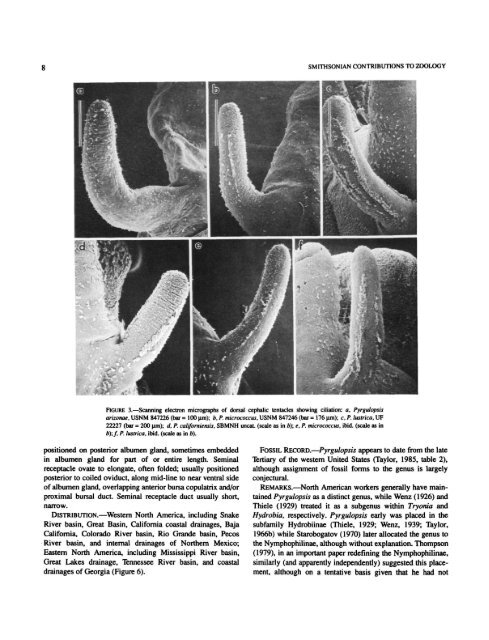A Review of the North American Freshwater Snail Genus Pyrgulopsis
A Review of the North American Freshwater Snail Genus Pyrgulopsis
A Review of the North American Freshwater Snail Genus Pyrgulopsis
You also want an ePaper? Increase the reach of your titles
YUMPU automatically turns print PDFs into web optimized ePapers that Google loves.
SMITHSONIAN CONTRIBUTIONS TO ZOOLOGY<br />
FIGURE 3.—Scanning electron micrographs <strong>of</strong> dorsal cephalic tentacles showing ciliation: a, <strong>Pyrgulopsis</strong><br />
arizonae, USNM 847226 (bar = 100 nm); b, P. micrococcus, USNM 847246 (bar = 176 Jim); c. P. lustrica, UF<br />
22227 (bar = 200 Jim); d, P. californiensis, SBMNH uncat (scale as in b); e, P. micrococcus, ibid, (scale as in<br />
£>);/, P. lustrica, ibid, (scale as in b).<br />
positioned on posterior albumen gland, sometimes embedded<br />
in albumen gland for part <strong>of</strong> or entire length. Seminal<br />
receptacle ovate to elongate, <strong>of</strong>ten folded; usually positioned<br />
posterior to coiled oviduct, along mid-line to near ventral side<br />
<strong>of</strong> albumen gland, overlapping anterior bursa copulatrix and/or<br />
proximal bursal duct. Seminal receptacle duct usually short,<br />
narrow.<br />
DISTRIBUTION.—Western <strong>North</strong> America, including Snake<br />
River basin, Great Basin, California coastal drainages, Baja<br />
California, Colorado River basin, Rio Grande basin, Pecos<br />
River basin, and internal drainages <strong>of</strong> Nor<strong>the</strong>rn Mexico;<br />
Eastern <strong>North</strong> America, including Mississippi River basin,<br />
Great Lakes drainage, Tennessee River basin, and coastal<br />
drainages <strong>of</strong> Georgia (Figure 6).<br />
FOSSIL RECORD.—<strong>Pyrgulopsis</strong> appears to date from <strong>the</strong> late<br />
Tertiary <strong>of</strong> <strong>the</strong> western United States (Taylor, 1985, table 2),<br />
although assignment <strong>of</strong> fossil forms to <strong>the</strong> genus is largely<br />
conjectural.<br />
REMARKS.—<strong>North</strong> <strong>American</strong> workers generally have maintained<br />
<strong>Pyrgulopsis</strong> as a distinct genus, while Wenz (1926) and<br />
Thiele (1929) treated it as a subgenus within Tryonia and<br />
Hydrobia, respectively. <strong>Pyrgulopsis</strong> early was placed in <strong>the</strong><br />
subfamily Hydrobiinae (Thiele, 1929; Wenz, 1939; Taylor,<br />
1966b) while Starobogatov (1970) later allocated <strong>the</strong> genus to<br />
<strong>the</strong> Nymphophilinae, although without explanation. Thompson<br />
(1979), in an important paper redefining <strong>the</strong> Nymphophilinae,<br />
similarly (and apparently independently) suggested this placement,<br />
although on a tentative basis given that he had not

















